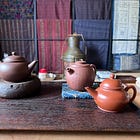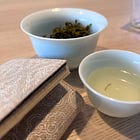立冬: 地始凍 | Beginning of winter: Land starts to freeze (72 microseasons)
Like a tiny drop of dew, or a bubble floating in a stream
Like a flash of lighting in a summer cloud
Or a flickering lamp, an illusion, a phantom, or a dream
So is all conditioned existence to be seen.
— The Diamond Sutra, Chapter 32 This is a year beyond my wildest dreams.
Surprises. Goodbyes. Broken imperfections. Of letting go.
But also new beginnings. Space. Stillness. Receiving and learning.
This Thursday is the World Diabetes Day. While many things have happened since my OpEd (reprinted in full below) was published early this year, the gist of it remains true.
We need movements in our lives. And movements require space. Not just in the physical sense but also moving flow in our emotional and spiritual lives. To have a healthy body, we need a suite of interventions: sleep, good diet, manageable stress, a healthy and balanced lifestyle that we can maintain overtime.
Tea, following my surprised diagnoses, came into my life this year.
It taught me time. It taught me that good things take time. It taught me that the very best things in life take time and need space. It taught me the importance of cultivating taste, suspending judgment, and choosing curiosity.
Japanese chado or Way of Tea, in essence, is a practice of yin yang balance. Of the host-guest relationship and the balance between our inner and outer worlds. The importance of slowing down during parting, transitory in between movements. E.g. slow and even lifting of chasen whisk out of chawan bowl.
Chinese tea is also a lifetime practice of balancing between taste, virtue, and life appreciation that forms the character 品. Anyone can drink tea 饮茶 and learn about tea 知茶. But to truly feel the tea 觉茶品尝 and to refine our five-sensorial taste 五感 takes time, space, and ongoing patience.
The truth is, achieving balance is not easy. We cannot be everything, everywhere, all at once.
And we don’t have real control over time.
But As Maria Popova, creator of the Marginalian, best expressed: "We do have a choice in how we orient it, how we inhabit the moment, how we own the past and open to the future — a choice that shapes our entire experience of life, that ossuary of time.”
Why sitting is the new smoking: My sudden diabetes diagnosis
Originally published in The Straits Times OpEd, 12 April 2024
If January symbolizes new beginnings, 2024 felt like stepping off a cliff into the unknown. I ended up hospitalized three days into the new year following intense stomach cramps and constant feelings of uneasiness. The frequent thirst and bathroom breaks just did not feel right.
“We’re going to have to admit you for diabetes. You also have a urinary tract infection,” the doctors said.
I was dumbfounded but did not resist. A million thoughts surged through my head. Shockingly, my blood sugar level is three times as high as the normal range, as finger-prick tests revealed. My haemoglobin result showed that I have unknowingly been living with diabetes for the last two to three months.
And for the second year in a row, I am diagnosed with yet another chronic health condition. In early 2023, I started experiencing finger numbness during sleep. An MRI revealed cervical spondylosis, a type of neck arthritis, causing bulging disk that affects nerves, leading to radiating pains from my neck to my fingers to other parts of my body.
Despite my annual health screening six months ago showing nothing amiss, I am thrown into this sudden onset of diabetes. I sit with the sinking feeling that I am now living a chronically ill life.
How could this happen?
Not once did I think that I was a prime candidate for Type 2 diabetes and cervical spondylosis. I am not obese nor did I have a family history of diabetes. I am relatively young as a 40-year-old and had thought of myself as reasonably healthy.
Looking back on why this happened to me, I can think only of one reason. My sedentary lifestyle, which was exacerbated by remote work, and my obsession with my work while juggling parenting duties. That left me little “me” time to mindfully care for my health or to exercise properly.
A year ago, I was mostly stuck in reactive mode, glued to the screen for hours, bouncing between emails, jumping from one Zoom call to another across time zones, rushing about between projects with external deadlines and often self-imposed ones. Remote work brought great flexibility and convenience to a busy working mother like me but also loneliness and an urge to feel useful, to forge connections with others - perhaps this pushed me to fall prey into mindless screen time.
For that, I paid a high price.
Sitting is the new smoking
Sitting too long can be deadly. People who spend most of their day sitting at work have a 16 per cent higher risk of dying from all causes and a 34 per cent higher risk of dying from heart issues. This is backed by a 2024 study by Journal of the American Medical Association (JAMA), involving over 480,000 participants over the course of 13 years.
Sitting too much can shorten one’s life and bring on a slew of serious health issues. Think blood clots; various cancers, including colon, breast, lung, prostate, ovarian; heart diseases; chronic pain conditions with back, hip, neck, joint pains; high blood pressure; high cholesterol; high levels of inflammation and reduced gut health; obesity; poor bone health and osteoporosis; poor posture with muscle tension and loss; and even stroke.
On top of the physical toll, many of us are unaware of how not moving enough cumulatively can affect our mental and emotional well-being, as well as cognitive functioning. In 2023, JAMA found that not moving around enough could raise your chances of getting dementia.
It’s safe to say that one can also add diabetes to the list.
From inactivity to insulin resistance
Already the odds are stacked against Asians.
More than 60 per cent of the world’s people with diabetes call Asia home. Six out of the top 10 countries with the highest diabetes rates are right here in this region. The situation is becoming more worrisome as diabetes does not just affect adults alone anymore - even kids are affected.
In Singapore alone, over 400,000 people live with diabetes. One in three Singaporeans have a lifetime risk of developing diabetes. The number is projected to rise to one million by 2050 if things do not change.
Physical inactivity is a matter of life and death. The World Health Organization (WHO) ranks physical inactivity as the fourth leading cause of death globally, claiming around 3.2 million lives each year. The scary part of this headline is that being sedentary messes with our blood sugar levels as a factor in developing Type 2 diabetes - which can potentially shorten lifespan by as much as 10 to 20 years.
Imagine this: As you sit for too long, day in and day out, the body becomes resistant to insulin, a hormone that lets your cells use sugar as energy. To compensate, the body starts pumping out more insulin to maintain normal blood sugar levels. Eventually, the body cannot keep up and the blood sugar starts to rise, leading to Type 2 diabetes.
The chain of reaction does not just stop there. When you are inactive, fat starts to build up, especially around your belly, making it even harder for the body to control blood sugar. Plus, your muscles start to shrink and weaken, which means that they are unable to store sugar from the bloodstream.
Implications for Asia-Pacific
In Asia-Pacific, over 40 per cent of adults are grappling with sedentary behaviour and physical inactivity, a concerning trend expected to worsen. Rapid urbanisation and modernization have led to shifts in work culture, with more people engaged in sedentary desk-based jobs rather than physically demanding occupations.
In our cult of always-on work culture, obsession with speedy productivity amplified by blurring lines between work and personal life exacerbate the problem. Workers struggle with digital boundaries and we get addicted with the chase of achievements to the point that we sometimes forget that we have a body.Additionally, technological advancements, widespread use of electronic devices, working from home with less commuting and infrequent in-person interaction time, can all result in increased screen time and decreased overall physical activity.
This needs to change.
While hitting 10,000 steps a day may not be realistic for everyone, any movement counts. Research such as the one evidenced by a 23-year study in Daqing in China, highlights the importance of long-term interventions in promoting an active lifestyle to manage blood sugar levels and preventing diabetes - underscoring the urgency of addressing sedentary behaviour.
Embracing mindful lifestyle
My day now begins early at 5:30 am before my two young children are awake. I kick-start it with warm-up stretches, box breathing exercises, and guided meditations - immersing into these for 30 minutes to about an hour. Plum Village is one of several apps that I currently use and this is a free mindfulness app developed by Zen master Thich Nhat Hanh and his community.
Tony Robbins, the self-help guru, is a huge believer in morning priming routines to ease into the day, to firmly anchor it during stressful times of great uncertainty.
Now, with more slack in my calendar as I prioritise health in my healing journey, I enjoy long walks lasting 30-60 minutes around the neighbourhood or at one of the historic temples in Kyoto. I also take regular breaks throughout the day, incorporating activities like matcha tea whisking, which I have found to be a meditative practice. It helps me slow down, appreciate the simplicity of preparing and savouring tea, and tune in to my body’s needs - all the while moving evenly from one task to another without rushing to the future.
To get better, I have realised, awareness is the first step.
“Make tea for others but more importantly, make time to make tea for yourself” as Dairik Amae, my chado 茶道 tea meditation teacher would say. In a society that has conditioned us to grind, it is even more important to pause, be more mindful about the everyday choices that we make, and to have the courage to set healthy boundaries in how we approach our world.
We owe it to ourselves and others to reclaim wellness by inviting mindful pauses and daily movement to combat a sedentary lifestyle. After all, if you do not make time for your wellness, you will be forced to make time for your illness.
When you drink a cup of tea very deeply, you touch the present moment and you touch the whole of time.
- Thich Nhat Hanh, Vietnamese monk and peace activist






This is a well-written piece of reflection, thank you for sharing!
Movement is so important, especially when I'm in cities that aren't conducive to walking and find my daily steps plummeting. Strolls in nature and around walkable areas are refreshing (much more than a treadmill walk!)
Wishing you all the best in your healing journey, Peck Gee.
This is really a timely and much-needed reminder. My father also has diabetes due to years of imbalanced lifestyle in his work, so I can relate to how painful this experience can be. We really need to bring balance to our daily life. A healthy body is the foundation of everything. Please take care!